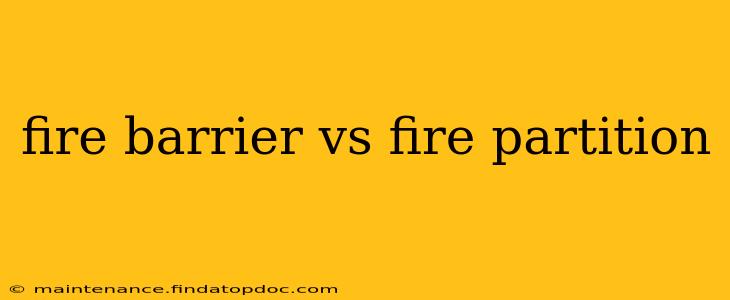Choosing the right fire protection system for your building is crucial for ensuring the safety of occupants and preventing the spread of fire. Two common terms often cause confusion: fire barriers and fire partitions. While both aim to contain fires, they differ significantly in their construction, performance, and applications. This comprehensive guide clarifies the key distinctions between fire barriers and fire partitions, helping you understand which is best suited for your specific needs.
What is a Fire Barrier?
A fire barrier is a fire-resistant assembly designed to restrict the spread of fire and smoke across a larger area, typically between different parts of a building or different occupancies. Think of it as a more robust and extensive fire-resistant wall or floor assembly. Fire barriers are rigorously tested to withstand significantly higher temperatures and longer durations of fire exposure compared to fire partitions. They are typically constructed using materials like concrete, masonry, fire-rated drywall, and specialized fire-resistant sealants.
Key characteristics of fire barriers include:
- High fire resistance rating: Measured in hours, these ratings indicate how long the barrier can resist fire penetration and heat transfer. Ratings often exceed those of fire partitions.
- Extended protection: Designed to prevent the spread of fire and smoke over larger distances and across multiple areas.
- Structural integrity: Often designed to maintain structural stability even after prolonged fire exposure.
- Penetration control: Meticulous attention to detail is required to ensure proper sealing of penetrations (e.g., pipes, conduits) to maintain the barrier's integrity.
What is a Fire Partition?
A fire partition, in contrast, is a fire-resistant assembly used to separate smaller areas within a building or a single occupancy. They aim to contain a fire within a specific space, preventing its rapid spread to adjacent rooms or areas. Fire partitions are typically constructed using less robust materials than fire barriers, leading to lower fire resistance ratings. Common materials include fire-rated drywall, steel studs, and appropriate sealants.
Key characteristics of fire partitions include:
- Lower fire resistance rating: Typically offering a shorter duration of fire resistance compared to fire barriers. Ratings are usually expressed in hours or fractions thereof.
- Localized protection: Primarily designed to compartmentalize smaller areas, limiting fire spread within a single occupancy.
- Less stringent construction requirements: Compared to fire barriers, they generally have less stringent construction requirements and may require less extensive firestopping.
Fire Barrier vs. Fire Partition: A Table Summary
| Feature | Fire Barrier | Fire Partition |
|---|---|---|
| Purpose | Restrict fire spread across large areas | Contain fire within smaller areas |
| Fire Rating | Higher (often multiple hours) | Lower (typically less than 2 hours) |
| Construction | More robust materials, higher standards | Less robust materials, simpler construction |
| Application | Between different building sections, occupancies | Within a single occupancy or floor |
| Cost | Generally more expensive | Generally less expensive |
What are the common applications of fire barriers and partitions?
Fire Barriers: Commonly used in:
- Separation of different occupancies within a building (e.g., separating a residential area from a commercial area).
- Dividing high-rise buildings into fire-rated zones.
- Protecting stairwells and corridors from fire spread.
Fire Partitions: Commonly used in:
- Dividing spaces within an apartment or office.
- Separating rooms within a single occupancy.
- Creating fire-resistant enclosures for hazardous materials storage.
What are the building codes and regulations for fire barriers and partitions?
Building codes and regulations regarding fire barriers and partitions vary depending on location and specific building characteristics. These codes dictate the required fire resistance ratings, construction methods, and testing procedures for both barrier and partition systems. It is imperative to consult local building codes and regulations, along with a qualified fire protection engineer, to ensure compliance and occupant safety. This information should not be considered a substitute for professional advice.
How much do fire barriers and partitions cost?
The cost of installing fire barriers and partitions varies significantly based on several factors, including the size of the area, the required fire rating, the materials used, and the complexity of the installation. Fire barriers tend to be more expensive due to their higher fire resistance ratings and more stringent construction requirements. Detailed cost estimates should be obtained from qualified contractors specializing in fire protection systems.
This information is for educational purposes only and shouldn't be considered professional advice. Always consult with qualified professionals for specific guidance related to your building’s fire safety needs.
